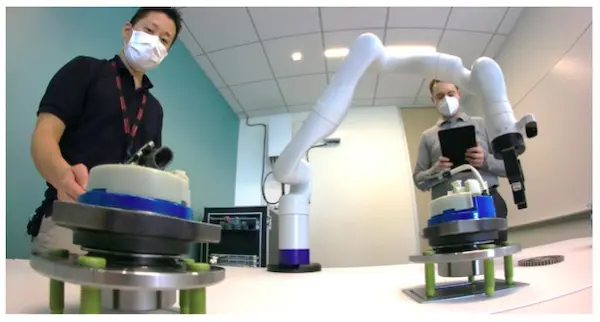
To accelerate the development of platform technologies and scalable solutions for digital transformation in multiple industries
Hitachi, Ltd. has announced that a dedicated 5G network has been installed at its Silicon Valley Research Center, part of the Research & Development Division of Hitachi America, Ltd. (Hitachi America) in partnership with Ericsson. The network will leverage 5G and Hitachi?s platform technology to accelerate the development and demonstrate the value of digital transformation across industries.
Fifth generation wireless network technology, commonly referred to as “5G technology,” is expected to drastically change the way society operates by providing ubiquitous connectivity with ultra-reliable low-latency communication. 5G has the power to accelerate the digital transformation of not just the telecom sector, but businesses across industries. Sectors that will benefit from the increased resiliency and efficiency that 5G technology affords include manufacturing, mobility, healthcare, energy, and IT, though the platform is also expected to support new business models.
Hitachi is taking a multi-pronged approach to developing technology solutions for the various layers of 5G, accommodating for regionally available infrastructure and needs. Leveraging Hitachi?s extensive Operational Technology (OT) knowledge accumulated over the years, as well as advanced digital technologies such as AI, Hitachi is developing Lumada solutions through collaborative creation with customers to resolve the various challenges they face and accelerate digital transformation within their businesses. 5G is expected to make business infrastructure more dynamic and improve business continuity and resilience in a “new normal” environment; Hitachi plans to enhance these benefits through “Lumada x 5G” to create added value for customers.
In a major step forward on this front, Hitachi America has partnered with Ericsson to install a dedicated 5G network in its Silicon Valley Research Center in Santa Clara, California. With this network, Hitachi America will be able to validate new 5G technologies and related solutions it is developing to generate an understanding of their potential value to customers. Hitachi America intends to start by testing manufacturing solutions using the 5G collaborative teleoperation technology co-developed with Georgia Institute of Technology (Georgia Tech) and continuing to work closely with Ericsson on joint development initiatives for industry solutions as a result of this new dedicated 5G lab network.
“Ericsson has been working with Hitachi and its ecosystem partners to identify use cases for co-development of industry vertical 5G-enabled IoT solutions to meet product pipeline demands as 5G adoption accelerates,” said Erik Josefsson, Head of Advanced Industries, Ericsson. “This new dedicated 5G network is another proof point in our collaboration moving forward.”
Collaborative robotics between humans and robots will be a key technology to leverage as our society works to achieve contactless, fully automated systems while maintaining human supervision. The remote control of industrial robots by human operators as well as intuitive operation of robots by analysis/control functions located on a multi-access edge computing (MEC) server will require high-speed detailed communication between humans and robots to enable accurate assessment of what is happening on site. Further, with the increasing trend towards personalization, today’s manufacturing industry is fast evolving towards hyper-customization done at scale, which will require flexible production lines.
The key technologies that are making flexible automation at scale possible are robotics and AI, with 5G and time-sensitive networking (TSN) serving as a digital backbone. Hitachi America, in collaboration with Georgia Tech, is developing novel applications to realize flexible automation powered by 5G edge AI technology. One such application is real-time and interactive remote collaboration between skilled workers and machines. Optimized control of the robot can be realized by the 5G edge AI technology allocated to the MEC server and by utilizing the wide variety of large-capacity sensor data (comprised of 4K video and TOF sensor information) collected from the site via 5G to support appropriate judgment by the remote human operator.
To validate this technology, a scenario case was assumed where a fully automated robotic arm picking task is affected by a malfunction. Such a situation may occur, for example, if the object to be picked up by the robotic arm is not positioned correctly or is of a different size or shape. Hitachi’s 5G edge AI technology provides seamless intuitive remote control of the robotic arm through the real-time analysis of comprehensive sensing data. This technology is expected to reduce work time by 50-70 percent compared to the conventional method, in which a remote operator directly controls a robotic arm. The technology incorporates flexible automation at scale, which will help usher the manufacturing industry into a new age of hyper- customization.
“Hitachi’s Silicon Valley Research Center will serve as critical proving grounds for currently emerging technologies relating to collaborative robotic systems,” says Sonia Chernova, Associate Professor in the Institute for Robotics and Intelligent Machines at Georgia Tech. “Adaptive automation requires access to high quality, multi-modal data from a wide range of sensors. Hitachi’s 5G capabilities are poised to revolutionize how such data is collected, aggregated, and analyzed at scale in real-time, helping to make the next generation of advanced robotic systems possible.”
The dedicated 5G network will provide a test environment for Hitachi America and Ericsson to explore 5G solutions in North America, as well as for potential interested customers to join Hitachi?s co-creation approach to accelerate development and validate the value of digital transformation. The combination of 5G and Hitachi’s platform technology has the potential to transform industries across North America.
Hitachi will continue to create innovative solutions through “Lumada x 5G” to catalyze changes in business infrastructure, improve business continuity and resilience, and add value for customers.
(1) The robotic arm in the image is a Kinova Gen3, a product of Kinova inc., purchased for research purposes only.




